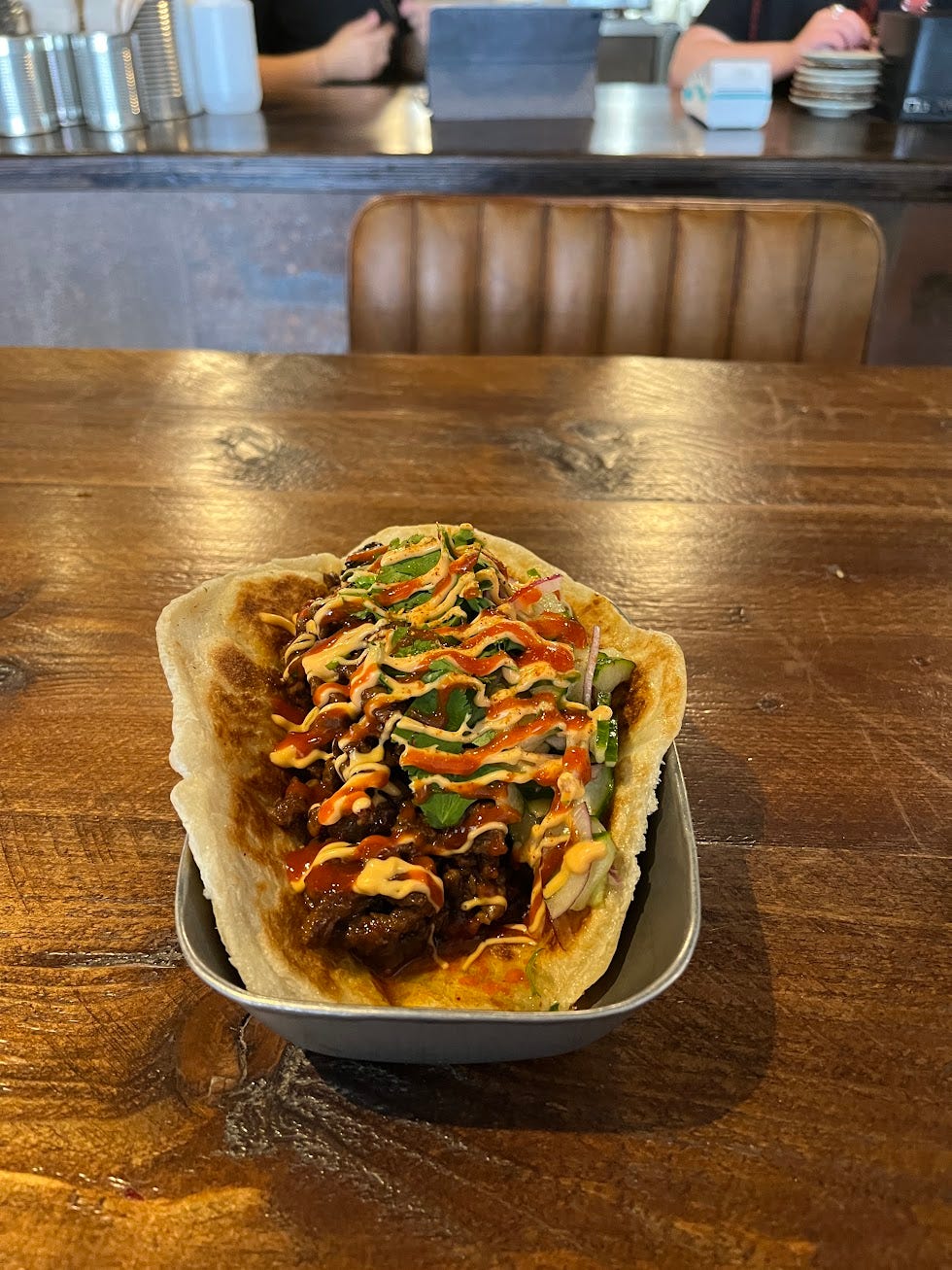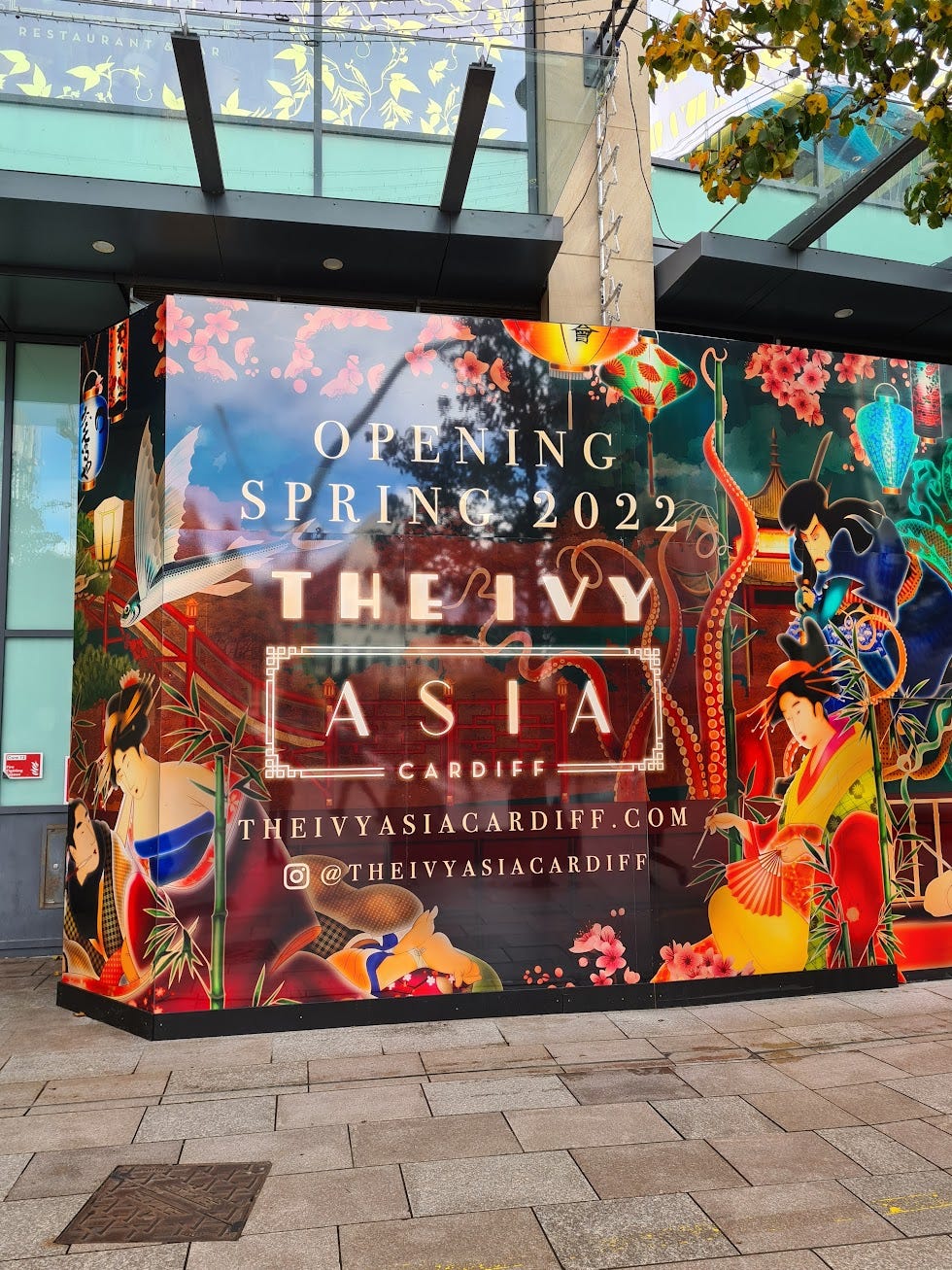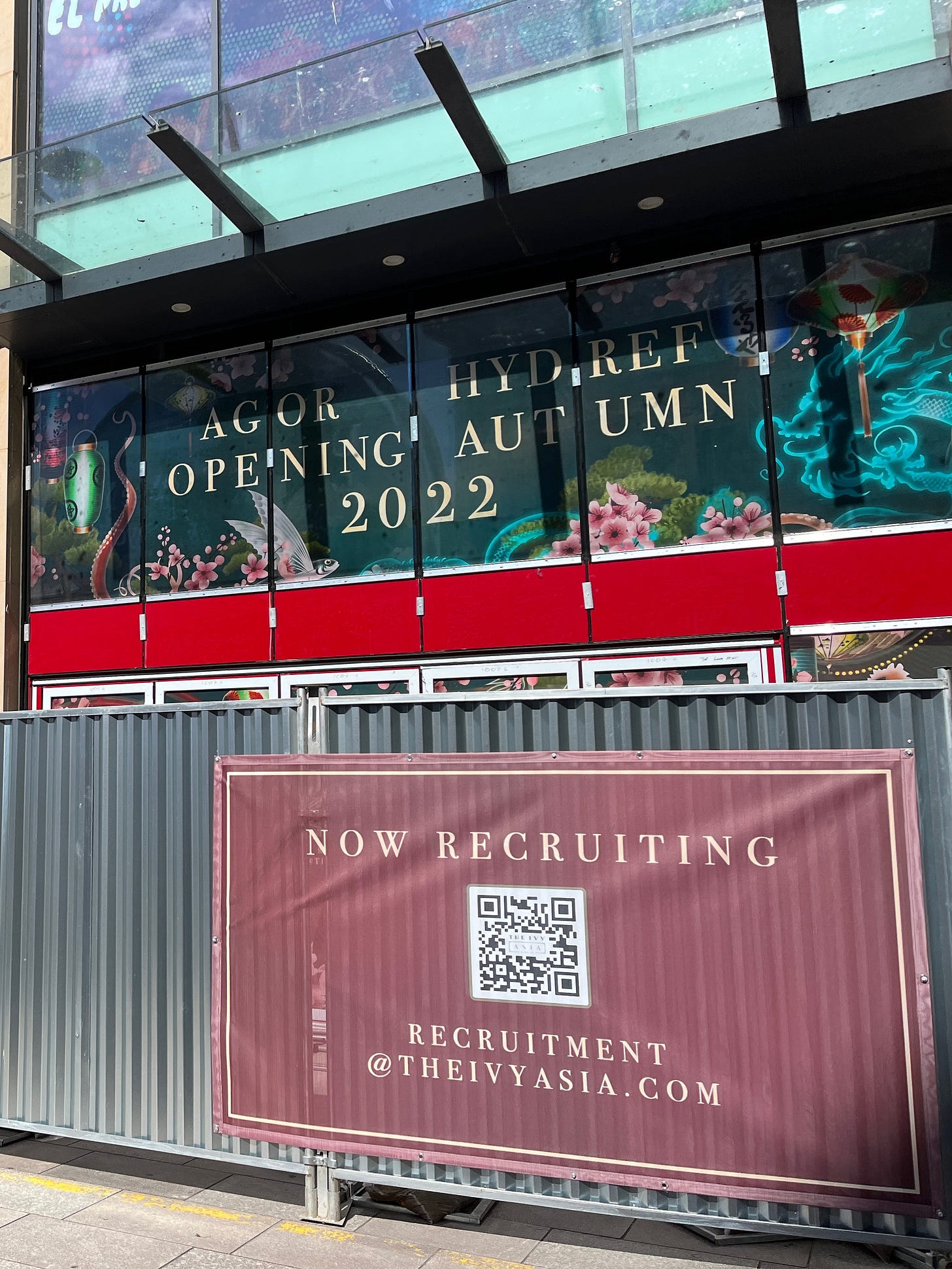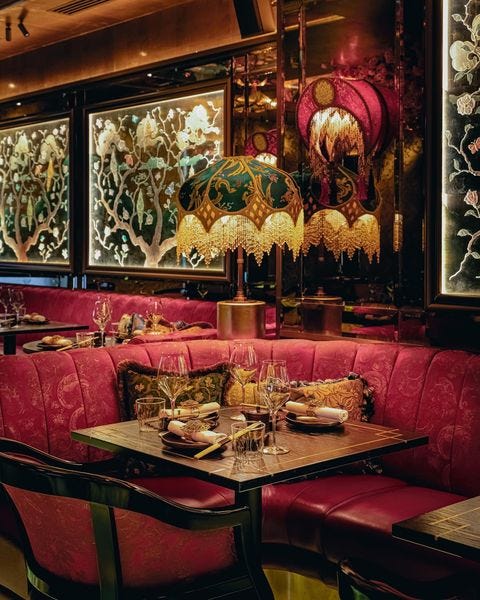A Tale of Three Asias
Or, why you won’t catch me walking into the Ivy Asia anytime soon.
Newsletter is back after I’ve been a little busy. Between getting a new job, and subsequently moving, I haven’t had the energy for any writing outside of my paid job.
I am highly aware that I should be writing the second part to Around Cardiff in 50 Snacks first. However, it’s a little hard to write about food in Cardiff when I don’t actually live there anymore.
I still have a rough draft of the piece, and it will get published when I have the time. But I had to get this one out of the way first.
I wrote this piece mostly all in one sitting, born out of long and deeply held emotions about the state of ESEA food, culture and representation in the UK today. Particularly, it’s centred around one new opening in Cardiff, and how it compares to two of Cardiff’s hottest restaurants.
It’s one of my longest and most personal essays I’ve released, and one I’ve wanted to write for a very long time.
Being and acting white has been hardcoded into my veins since I was born. As a second-generation immigrant of Chinese-Malay and Irish parents, being a third-culture kid has always been an inescapable aspect of my life.
As the whitest-passing member of my extended family, my existence has always sat in limbo. I don’t speak Malay or any form of Chinese, so have never felt Asian enough. But I have always been just outside the borders of regular whiteness to be singled out as ‘different’, particularly as a child.
So it may come as a surprise that I actually don’t really care about pure authenticity in food. As the product of a mixed-race background and growing up with bastardised Malaysian and Irish snacks, unauthentic food has long held a grasp on me. To me, unauthentic foods tell just as interesting of a story, born out of innovation and necessity, made with just as much care.
Particularly as dining out choices have never been better, society has shifted towards the fetishisation of authenticity as a primary driving factor for diners. In many cases today, the inclusion of authenticity seems little more than a buzzword to attract diners, with little actually achieved towards the recontextualisation of foods that the West may have previously whitewashed.
That’s not to say the whole push towards authenticity is entirely void of merit. For many, it has been a fightback against years of westernised dilution; to consume and honour the traditions of yesteryear from generations prior where modernity had hollowed out its history and soul. After years of subtle tweaks and substitutions from shameless businesses with quickly seizing market opportunities and grabbing the cash before anyone could really notice, minorities finally had a stepping stone to reclaiming their own tradition, culture, and food.
That being said, I never search for my next meal with authenticity in mind. Browsing social media, I often encounter those who do — TikTok and Instagram accounts of modern bloggers who, when frequently failed by words beyond the simplistic millennial lexicon of “good” and “lush”, immediately flock to pressing the big red authenticity button.
In reality, it’s a cop out. These accounts mean well in hoping to expand their palates into something beyond the homogenised high-street offerings of Nandos, Wagamama et al. But they’re almost always white, middle class, and hyper-focused on the modern social currency of a restaurant’s authenticity as opposed to the wider culture they encompass. It is also worth noting that almost all of the bloggers that gain attention across social media are white and middle class, but that’s a whole different issue that extends far beyond the reach of this article.
Within Cardiff, this is especially true, and there are three Asian restaurants that tell their own unique stories. How each arrived at the food of east and south east Asia (ESEA) differs greatly, but each has its own lesson in the world of food.
The first element of this story is Brother Thai. In the past, I’ve described the restaurant’s food as fantastically unauthentic; a comment I stand by to this day.
In short, stuffed rotis simply don't exist in Thailand. As a matter of fact, rotis aren’t even really eaten there either. They’re a Malaysian and south-Asian staple.
Owner Andrew Chongsathien has lived his whole life in Britain, having grown up in Bridgend before living most of his life in Cardiff. His story, his menu is one all too familiar to the ESEA diaspora spread out across the west — it’s a story of adaptation and survival through improvisation.
You won’t find food like his elsewhere in the world, but one bite of his rice bowls or rotis will transport your palate in the centre of bustling Bangkok. The fragrance of lemongrass, lime leaves, coconut milk, chillies, lime play a graceful homage to the rich culinary history of Thailand through new mediums.
I will never have anything but praise for this place. It is a temple devoted to the food of Thailand that shines light on the history and culture of the country, without feeling the need to explain itself. Where the sticky beef roti and chicken satay are not Thai at all, each dish is delivered and constructed with the care and consideration of someone looking to honour their heritage above all else.
Contrary to this entire bit, I recently saw an Instagram story that described its food as “the most authentic Thai food outside of Bangkok.” In plain terms, the comment was demonstrably false. But you can’t blame them, though. This is food so well constructed it actually manages to deceive you into thinking they’re dishes that possess the rich history and generations of gentle perfecting behind them.
Similar to how Cantonese and Bengali migrants adapted the foods of their homeland through substitutions and simplifications to create the standardised and staple menus of the nation’s favourite takeaways, Chongsathien has kept his heritage alive through innovation and avoiding the sweeping stereotypes attached to his family’s home country.
There are many businesses like this in Cardiff, though. What has kept Brother Thai a continued and unrivalled success story is Chongsathien’s care and attention to detail at the beating heart of the business.
The interior is sleek, modern, and chic, with lo-fi electronic music selected to curate the perfect ‘buzzy’ atmosphere that’s plays the careful balancing act of being both laid back and energetic for diners. It’s is wholly relaxed for guests, but it’s no accident.
It is the result of a well-oiled machine, and a testament to his passion for hospitality at his core. Chongsathien is a man who will never be fully pleased — each day, week, and month, he will tinker and toy with every aspect of the restaurant to make every detail perfect.
Away from the chop suey typeface and stereotypical accoutrement, Chongsathien has created a truly unique space that both entertains and educates diners on through subverting their expectations on modern Asian food and culture, and Cardiff is lucky to have him.
On the other side of the city comes an entirely different story of an outsider who has found himself into diving headfirst into Asian food and culture.
Almost everyone is familiar with the story of James Chant at Matsudai Ramen at this point. There have been numerous articles, my own included, that have covered his journey from music creative to ramen chef, to noodle mogul, sprouted from his own home kitchen.
I’ve had the fortune of speaking with James a few times across the lifespan of Matsudai. From when I first interviewed him after moving production to the small unit in Taff’s Well, to the popups in Milkwood and beyond, his care, passion and respect for the craft have been a constant thread throughout. Now, he’s launched his own restaurant, something he’s always wanted since the business kicked into gear.
But James was never a chef prior to Matsudai. Better yet, prior to founding Matsudai, he had never eaten a bowl of ramen in Japan.
This is something he’s always been highly aware of. Within one of my earliest interviews with him, he was noticeably wary regarding the idea of appropriating a culture and cuisine of which he had no prior connection or knowledge.
Addressing his desire to eventually open a restaurant over two years ago, his insistence on ensuring every detail was correct was already present, refusing to tiptoe around the ethnic elephant in the room. He knew where he stood in the grand scheme of things, and how it may look from the outside.
After all, the hard truth of the matter is quite simple. How could James create truly ‘authentic’ Japanese ramen without having even eaten in within its borders? Regardless of how far technology has advanced, it remains impossible to tour the taste of the world without actually being physically present in a location.
Yet, through years of almost exclusively internet research — via endless browsing of subreddit threads — and meticulously trial and error, James has managed to craft a product that gets people travelling for miles, or does miles travelling to them. Each popup only got better over time; each broth more balanced and concentrated; each bite of curried karaage more tangibly crunchy and complex.
But is it authentic? Probably. I don’t know — I’ve never been to Japan. Is it the best ramen I’ve ever eaten? Unquestionably.
But even if it wasn't, my concluding thoughts would remain all the same. Chant’s story and ethics match Chongsathien. His refusal to fall into complacency and dishonour the art of ramen construction — and the country of Japan in the process — is far more valuable when considering his work, rather than an authenticity points scoring contest.
On the surface, James Chant may just be another white guy from Cardiff who’s decided to cash in on the foodstuff of elsewhere in the world. But his care, commitment, and desire to create somewhere to feel proud of is what makes his business special. The near-universal praise his business has received is well-warranted, and is only guaranteed to increase now he’s curated a permanent space of his own.
And, as it has been well noted already, his self-awareness extends far beyond that of ESEA foods. With his restaurant opening in the predominantly Muslim neighbourhood of Grangetown, his refusal to sell pork-based broths only further shows his desire to integrate within his local community and build something truly special.
The reality is that it doesn’t matter who you are, where you are from, or what you look like as a chef. The only real criteria is that you care.
Which then arrives us at the third, and saddest, chapter of the story.
After numerous delays, the Ivy Asia will finally make its debut in Cardiff city centre. Sat adjacent to its “regular” offering, the Ivy Asia’s seventh UK location has been in the works for over a year, replacing a location of Jamie’s Italian.
To give them some credit, it’s actually impressive they managed to find a replacement that’s somehow more culturally offensive than the Naked Chef’s attempt at giving the world a taste of Italy.
I was blissfully unaware of the brand until it came under severe and deserved criticism for an advertising campaign involving some of the worst stereotypes I have seen in the modern age.
Presented in the video is a wild range of brazen racism, built on archaic and dated stereotypes of ESEA people that should have long been left in the past. In reality, the video may as well have knocked on the door of every ESEA person in the UK, ringing their doorbell, before shouting ching chong at them and running away at top speed.
Even though it was produced by an external agency, it is simply inconceivable that nobody within the Ivy Asia’s team had recognised the issues that campaign held.
After the video was met with fierce and deserved backlash, a standardised “sorry to anyone who found it offensive” line was quickly shifted across all channels. The video was taken down, but its images remained burned into the memory of Asians across the UK.
So why, particularly in the wake of the pandemic where attacks on Asian people across the world exponentially have exponentially increased, has the Ivy Asia doubled-down on their identity?
It would be much easier to set aside the video as a one-time misstep if it wasn’t for the interior of each of their restaurants. Dark and gloomy, they aim to mirror the mystery of east Asia, as if we don’t just eat like regular fucking humans in normal dining rooms.
Wall-to-wall ‘lucky’ red and jade ornaments galore, it’s a clusterfuck of décor so viscerally caricature, one almost expects John Wayne in yellowface to appear from behind a bamboo façade and grab the order for your table while squinting his eyes and mispronouncing the letter R.
The new Cardiff restaurant will not seek to undo this, and will reaffirm the brand’s continued mission of presenting Asians as a monolithic entity away from any form of nuance.
Through continued inaccurate presentations of east-Asian culture, the brand has created a unique identity for themselves unlike no other in the modern restaurant scene (Whether or not that’s because the rest of society has understood that shifting away from these stereotypes is the morally justifiable thing to do, is another question really).
But perhaps the brand’s success hurts the most because they will never have to live with the consequences of their continued fetishisation and simplification of ESEA cultures. When they make an offensive video, they face a little bit of bad PR, with a sprinkling of guilt (if we’re lucky), before they return to their regularly scheduled lives.
For those affected by the video, it reopens age-old wounds of implicit biases and explicit encounters of racism built upon the same stereotypes at the very foundation of their brand.
For them, normality is resumed — their bad coverage will be forgotten in a matter of time. For me, my mind is flooded with memories of being called a chink on the playground, or being randomly selected for questioning on whether or not I, and the only other Asian people from a flight from Paris, been near China by a border guard in Wales at the start of the pandemic.
So, quite hilariously for a restaurant, it’s not even about the food. That doesn’t mean it’s off the hook though.
Spanning sushi, dim sum, and even some Chinese takeaway classics, its menu is a selection of the foods of ESEA, centrally prepared and sloppily constructed.
In theory, this should be a slam dunk for the business — a greatest hits tour of the best foods Asia has to offer. Unfortunately, it dispenses a package with all of the charm of a Maroon 5 cover album of ABBA Gold — great source material, diabolical delivery.
Naturally, it would help to give the restaurant group a bit of leeway if the food was actually worthwhile. But, when its knowledge of the varied cuisines of Asia fails to advance past saturating every dish with peanut butter, sesame oil, and a small garnish of spring onions, I feel little but despair.
Add in that the business reportedly uses brazenly disrespectful employment drives — such as reportedly walking into the venues of the 44 Group and telling its workers they should move jobs while on shift — my feelings turn only towards anger.
And yet, while I will never set foot within this institution, I feel a natural sense of helplessness. I know exactly how this story will go, and there is little I can do to alter its path.
With a marketing budget strong enough to drown out any and all valid criticism of its operation and identity, social media will be saturated with positive accounts of their time there. Comping the meals of enough bloggers to turn the tide is but a splash in the ocean for The Ivy.
For so many other businesses across the country for whom margins have become ever tighter, they simply can’t afford to keep pace. Businesses, like Brother Thai, Matsudai, and countless others, will receive a mere fraction of the publicity when the Ivy Asia opens, no matter how much more care, consideration, and thought they place into every detail of their business.
As the utterly unfeasible economic environment is disproportionately forcing many minority and independent businesses to close, for a chain so arrogantly offensive as the Ivy Asia to be expanding, simply adds insult to injury.
It’s taken years of my life to finally be proud of being Asian in the UK. The Ivy makes me want to recede quietly back into the corner.
For Chongsathien at Brother Thai, being Asian is all he has ever known since birth.
For Chant at Matsudai, embracing and respecting Asian food and its rich culture and history is something he has thrown himself into wholeheartedly.
For the Ivy, being Asian has never been anything more than a business opportunity, and an offensive one at that.
Eating in restaurants extends far beyond the realm of the pursuit of good food. Every memorable restaurant is a lesson that both puts you at ease and challenges you to explore your senses fully. They provide a sense of comfort like no other.
Each time you are sitting in their dining room, your fate lies in the hands of your chosen restaurant. You are to surrender yourself to your surroundings, and in doing so are supporting the restaurant in its entirety, not just for what arrives on a plate in front of you.
Food has always been political, and to pretend otherwise is naivety at best and sheer ignorance at worst. But more so than ever today, where you choose to eat matters.
I will never seek out restaurants on the sole basis of authenticity. Today, its utilisation as a buzzword has detracted from its original purpose, and fails to register many other factors driving behind today’s restaurants.
Similarly, I will never walk through The Ivy Asia’s doors. I cannot support a business that actively chooses to present the rich and varied culture of ESEA people as some facile society of jade and red born out of little more than a Google search and an 80s kung-fu movie moodboard.
At every restaurant, each menu designed, cocktail carefully crafted , playlist curated, napkin gently placed is the invisible thread that ties together your restaurant experience.
Every element in a restaurant is no accident; it is a deliberate decision. For those like Chant, Chongsathien and so many others, they have chosen to do nothing more than create the best they can, and then some more. They have chosen to represent Asia with the respect it deserves, regardless of their background.
For the Ivy Asia, they have taken the conscious decision to create an environment rotten to its very core.
If the world continues to travel the way it’s headed, you may not have long before many businesses that do care close up for good. So choose wisely.
For those looking to explore UK ESEA stories in more depth, besea.n is currently hosting an ESEA heritage month with a wide range of events across the UK for people to take part in or watch.
In terms of books, Takeaway by Angela Hui is her memoir of growing up behind the counter as a Chinese takeaway kid in the Welsh Valleys. It’s an incredible read that perfectly navigates food, race, and how they interchange. The book also has its own directory of ESEA reading and resources at the back. Buy it!
Outside of the UK, Crying in H Mart by Michelle Zauner is also poignant as much as it is devastating, as she writes about her experience and relationship with race as a second-generation Korean-American. It’s a real tear-jerker, and is probably one of my favourite reads of the last few years.









